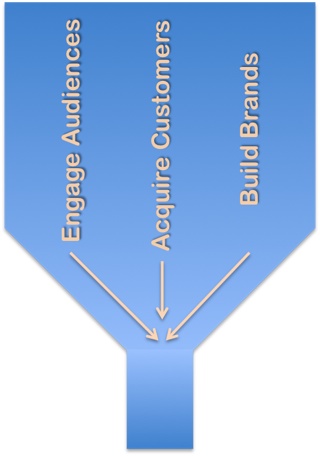Conventional wisdom suggests that a decade ago, digital agencies emerging from the ashes of the dot-com bust had a tough road ahead. The exuberance at the turn of the millennium was a distant memory, and going forward, transparency and accountability would be the law of the land. The biggest shops with the swankiest offices would still get by on their agency brands and long-standing relationships, but in the first decade of the 21st century, big changes were afoot.
Notable technology titans were bringing to market solutions that would level the playing field for everyone, for example:
- Google AdWords picks up steam as a key adoption platform.
- Yahoo and Microsoft offer scale via their own search offerings.
- YouTube spawns a brand new experience of online video consumption.
- Google Analytics brings website traffic analysis to the masses, free of charge.
- WordPress offers the public an open-source solution for limitless self-expression.
- Facebook offers an advertising platform with unprecedented consumer targeting.
Last month, with all of the industry focus on Google’s quarterly earnings, an announcement from Mountain View slipped by with limited fanfare – one which should indeed be profoundly interesting to agencies, brands, and Wall Street alike.
With its launch of Consumer Surveys, Google has in fact added a whole new dimension to the self-service model of audience engagement, customer acquisition and brand building.
Traditionally only accessible via high-powered consumer research technologies like Dynamic Logic, Google’s solution allows for tailored outreach based on standard demographic targets (age/gender/geographic), as well as “custom audiences” built around threshold questions (e.g. “do you drive a hybrid or electric car?”).
Google’s alternative, low-cost option canvases a statistically representative sample of the U.S. population. This in effect parlays the scale of Google’s partner network into yet another game-breaking solution for marketers. Only instead of turning the page with another incremental innovation, this indeed is opening an entirely new book.
Big brands maintain relationships with research companies of all shapes and sizes, from the heavyweights like Nielsen, IRI and NPD, to smaller specialized outfits with a unique angle on a particular industry, category or audience. They do it for one overarching reason: because an investment in consumer intelligence will almost always cost less than the risk of learning from their mistakes.
Why waste a million dollars reaching out to the wrong target audience, when a small fraction of that sum could be spent identifying the right audience at the outset? Now, with a low-cost technology allowing virtually anyone to deploy consumer surveys, it’s harder than ever to argue with this logic.
 No matter how advanced our industry becomes, media management continues to be permeated in customer attrition. You cast out to a large group, collect a bunch of costly data, hack off certain audience segments, push harder to grow others, rinse and repeat.
No matter how advanced our industry becomes, media management continues to be permeated in customer attrition. You cast out to a large group, collect a bunch of costly data, hack off certain audience segments, push harder to grow others, rinse and repeat.
We’re already far more advanced that our counterparts of the 20th century, whose media measurement capabilities were a far cry from the technologies of today – but we needn’t stop there. With a foundation built on solid market research, we can engage consumers at all points in the purchase funnel, and act on a variety of digital marketing objectives.
So what kinds of questions should researchers and marketers ask via consumer surveys, to improve media performance and engage, acquire, and build?
Driving Engagement
- Which offer would be more appealing to you, “Free Shipping” or “Buy One Get One Free”?
- If we offered a mobile app designed to enhance your in-store experience, would you download it?
- What is the #1 reason you clicked “Like” on our Facebook page?
Acquiring Customers
- Where do you most frequently purchase this product or service? Check all that apply.
- When was the last time you were in the market for this product or service?
- Of the following product features, which ones are most relevant to you? (Acquisition based media delivery can then be tailored to demographic profiles of respondents.)
Building Brands
- From the following list, please choose the brand that you believe offers the best product/service, and specify why you chose it.
- Which of the following is the most likely reason you would recommend us to friends and family?
- If you’ve purchased our brand more than once, what prompted you to come back to us?
We’re just scratching the surface here. With more detail around your brand, category and marketing objectives, there are infinite opportunities to put this type of consumer research to use.
The formula is simple: with pre-emptive research, you acquire the insights that grease the purchase funnel, minimizing the drag that is encountered in the delivery of media. And you don’t have to stop there: this type of research methodology can also be used for applications like sales, customer service, and product development.
This amounts to a big win for stakeholders across the board: brands get closer to their roots, agencies look like rockstars, and Wall Street licks their chops as Google adds yet another complementary technology to keep marketers fixated on AdWords.
There are already some good case studies available; has anyone else rolled this out with success?
 No matter how advanced our industry becomes, media management continues to be permeated in customer attrition. You cast out to a large group, collect a bunch of costly data, hack off certain audience segments, push harder to grow others, rinse and repeat.
No matter how advanced our industry becomes, media management continues to be permeated in customer attrition. You cast out to a large group, collect a bunch of costly data, hack off certain audience segments, push harder to grow others, rinse and repeat.